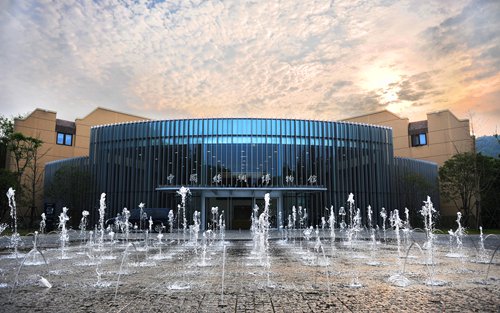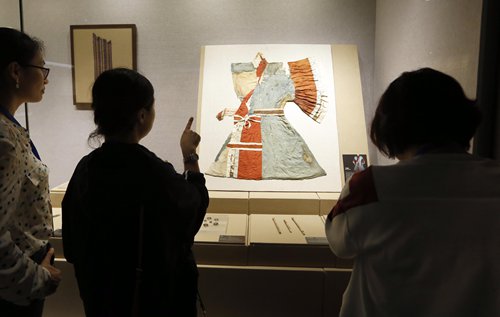Hangzhou exhibition marks fifth anniversary of Silk Road’s world heritage status
By The Paper - Global Times Source:Global Times Published: 2019/6/24 17:58:39

The China National Silk Museum Photos: IC

Visitors explore the Life along the Silk Road, Little Stories during the Great Era exhibition at the China National Silk Museum in Hangzhou on Friday. Photo: IC
The Life along the Silk Road, Little Stories during the Great Era exhibition kicked off at the China National Silk Museum in Hangzhou, capital of Zhejiang Province, on Friday. Featuring more than 500 items from both domestic and foreign museums and institutions, the exhibition presents the life stories of 13 people from different eras, nationalities and social statuses to give visitors a glimpse of what life was like along the Silk Road during ancient times.
Joint display
According to Chinese news outlet the Paper, 107 items are on loan from the State Hermitage Museum in Saint Petersburg, Russia. They account for one of the four sub-exhibitions, The Prairie Silk Road, that make up the exhibition.
Also known as the Winter Palace, The State Hermitage Museum ranks right up there in fame with the Louvre Museum in Paris, the British Museum in London and the Metropolitan Museum of Art in New York. Most of the borrowed items are heritage discoveries from the famous Pazyryk Cemetery and Noin-Ula burial sites.
Located in the Altai Mountains, the Pazyryk Cemetery contained relics showing the history of the nomadic tribes that lived in the region during the 3rd century BC. According to Zhao Feng, the curator of the exhibition and the China National Silk Museum, five pieces of silk unearthed from the Pazyryk Cemetery reveal how far Chinese silk had traveled at the time. Visitors can view the silk border of a felt carpet featuring a war scene and a tree. The carpet is the earliest evidence of the spread of Chinese silk.
The Noin-Ula burial site was a cemetery ground for the Xiongnu, a nomadic people that inhabited the eastern Asian Steppe. The unearthed relics from the Xiongnu show that the tribal people greatly loved Chinese jade, bronze and lacquerware.
The items from the other sub-exhibitions - the Prelude, The Desert Silk Road and The Maritime Silk Road - are all from Chinese museums and institutions and were mainly discovered at grand cemetery sites or underwater archaeological sites, such as the Li Xian Tomb and the Nanhai One wreckage site.
As this year marks the 70th anniversary of the establishment of China-Russia diplomatic relations, numerous activities are being held by the two countries.
Special perspective
The largest silk museum in the world, the China National Silk Museum holds a Silk Road exhibition annually to mark the anniversary of the successful application of the Silk Roads: the Routes Network of Chang'an-Tianshan Corridor as a UNESCO World Heritage Site on June 22, 2014.
Figuring out how to make the annual theme exhibition interesting and special poses a particular challenge for the museum staff. Zhao noted that most of the Silk Road exhibitions have taken a big picture perspective when introducing culture. Some are simply collections of important cultural relics, while others told stories about the Silk Road's geography and history. This time, however, the exhibition focuses on people.
"Those people were the constructors, protectors and witnesses of the Silk Road, no matter if they were ambassadors, merchants, herdsmen, soldiers or monks," Zhao said.
The name of the exhibition comes from the title of British scholar Susan Whitfield's work Life on the Silk Road. It uses actual historical relics to tell the stories of 10 people and present a broad picture of the Silk Road.
Based on evidence
Delivering a convincing presentation of the lives of people living in ancient times is no easy task, especially when it comes to figures from certain social backgrounds.
According to Zhao, the exhibition received the support of a knowledgeable group of experts, including Peking University professor Rong Xinjiang and other scholars from different fields. Until the exhibition finishes on September 8, the museum will invite these experts to give lectures on different subjects related to the exhibition.
Zhao emphasized that the stories being told are all based on evidence provided by the relics on display and not from the imagination of the organizers. For example, the story of a post house chief is based on a record unearthed from the Xuanquan Post House site. It tells the life story of a person who was in charge of welcoming and bidding farewell to passersby and officers as well as delivering government letters, documents and even military intelligence.
Meanwhile, a display of exquisite silk clothing and valuable daily wares and ornaments reveals the luxurious lives of the ruling classes, such as a young woman from an influential and respectable family.
Newspaper headline: ‘Little Stories’
Posted in: GALLERY,ART,CULTURE & LEISURE,ARTS FOCUS